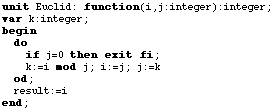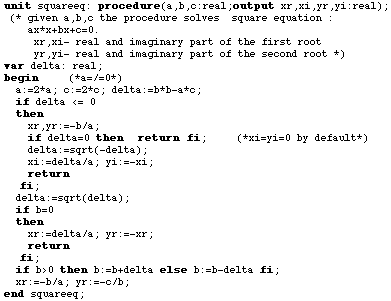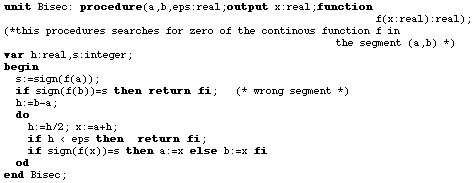 4) Procedures and
functions
4) Procedures and
functionsLoglan 82, A micro-manual of the programming language - Basic constructs and facilities
 4) Procedures and
functions
4) Procedures and
functionsProcedures and functions are well-known kinds of units. Their syntax is modelled on Pascal's, though with some slight modifications. Procedure (function) declaration consists of a specification part and a body.
Example:

Procedure or function specification begins with its identifier preceded by the keyword unit. (The same syntax concerns any other module named unit.) Then follows its kind declaration, its formal parameters (if any), and the type of the returned value (only for functions). A body consists of declaration lists for local entities and a sequence of statements. The keyword begin commences the sequence of statements, and is omitted, if this sequence is empty. The value returned by a function equals to the most recent value of the standard variable "result", implicitly declared in any function. This variable can be used as a local auxiliary variable as well.
Example:

The optional identifier at the end of a unit must repeat the identifier of a unit. It is suggested that the compilers check the order of unit nesting, so these optional occurrences of identifiers would facilitate program debugging.
All the local variables of a unit are initialized (real with 0.0, integer with 0, boolean with false etc.). Thus , for instance, the value of function Newton is 0 for m>n, since "result" is also initialized, as any other local variable.
The return statement (return) completes the execution of a procedure (function) body,i.e. return is made to the caller. If return does not appear explicitly, return is made with the execution of the final end of a unit. Upon return to the caller the procedure (function) object is deallocated.
Functions are invoked in expressions with the corresponding list of actual parameters. Procedures are invoked by call statement (also with the corresponding list of actual parameters).
Example:

Formal parameters are of four categories: variable parameters, procedure parameters, function parameters and type parameters (cf p.8). Variable parameters are considered local variables to the unit. A variable parameter has one of three transmission modes: input, output or inout. If no mode is explicitly given the input mode is assumed. For instance in the unit declaration:

x,y,b are input parameters , c,i are output parameters , and j is inout parameter.
Input parameter acts as a local variable whose value is initialized by the value of the corresponding actual parameter. Output parameter acts as a local variable initialized in the standard manner (real with 0.0, integer with 0, boolean with false etc.). Upon return its value is assigned to the corresponding actual parameter, in which case it must be a variable. However the address of such an actual parameter is determined upon entry to the body. Inout parameter acts as an input parameter and output parameter together.
Example:

A procedure call to the above unit may be the following:

where g,h,gi,hi are real variables.
No restriction is imposed on the order of declarations. In particular, recursive procedures and functions can be declared without additional announcements (in contrast to Pascal).
Example:
For two recursive sequences defined as:
a(n)=b(n-1)+n+2 n>0
b(n)=a(n-1)+(n-1)*n n>0
a(0)=b(0)=0
one can declare two functions:

and invoke them:
k:=a(100)*b(50)+a(15);
Functions and procedures can be formal parameters as well.
Example:

In the above declaration, after the input variable parameters a,b,eps and the output variable parameter x, a function parameter f appears. Note that its specification part is complete. Thus the check of actual-formal parameter compatibility is possible at compilation time. Making use of this syntactic facility is not possible in general, if a formal procedure (function) is again a formal parameter of a formal procedure (function). The second degree of formal procedures (functions) nesting is rather scarce, but LOGLAN-82 admits such a construct. Then formal procedure (function) has no specification part and the full check of actual-formal parameter compatibility is left to be done at run time.
Example:

Procedure G is a first degree parameter, therefore it occurs with complete specification part. Procedure H is a second degree parameter and has no specification part. In this case a procedure call can be strongly recursive:
